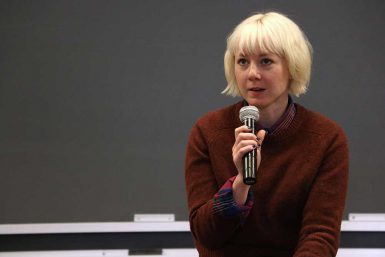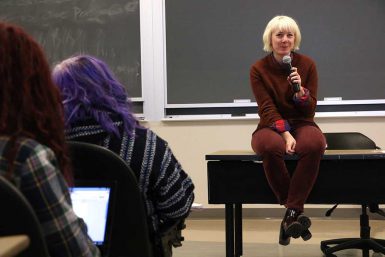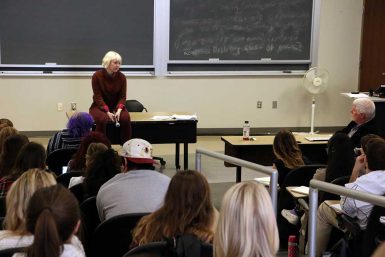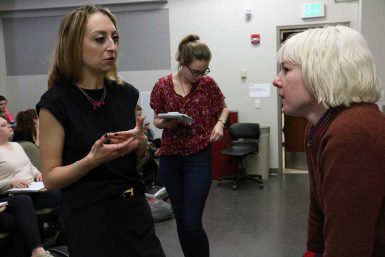Hess shares experiences reporting on online culture

Amanda Hess is not new to hearing criticism of her work. But since beginning her journalism career in 2007, the Slate writer has come in contact with a number of harassers, many using derogatory language and making threats from behind their computer screens.
During a visit to campus Feb. 29, Hess told students that online harassment tends to come in higher volumes when female journalists write about certain topics and often has nothing to do with their work.
“Women have gained so much visibility and so many spaces to speak their minds — in my case to have this journalism career — but one way that some people can still bring women down is by assaulting them or reducing them to their bodies,” Hess said. “That’s what’s happening online, a way for men to exert power over women.”
Hess spoke to professor of practice Tom French’s Behind the Prize class about her experiences, many detailed in her piece, “Why Women Aren’t Welcome on the Internet,” which won the National Magazine Award for public interest in 2015. French invites numerous media pros who have won top prizes or have been finalists to speak to the class about their careers.
Hess shared her experiences as a reporter on culture — especially sex, feminism and technology — and gave tips to young people preparing to enter the journalism profession.
“I write things that are meant to be provocative. I want to provoke a response,” Hess said of her pieces on Slate, in The New York Times Magazine and other news media.

For example, some of her recent work looked at “The Rise of VR Porn,” “Stolen, the App for Buying People,” and Hillary Clinton’s and Donald Trump’s social media campaigns.
Some of her work has sparked threats on social media, and a few people have harassed her for several years. The threats rarely addressed anything Hess wrote but rather focused on her appearance, threatened bodily harm and described violent acts. In attempting to report the harassment, she found that police weren’t sure how to address a cyber crime and that few other agencies offered solutions.
Hess used her experience to craft “Why Women Aren’t Welcome on the Internet,” describing how the legal system, common business practices and social media limit or permit online harassment.
“At first I looked at academic journals,” she said. “I was looking for law journals that had grappled with this kind of issue, so I was doing a bunch of searches that were like ‘Internet threats.’”
She discovered one contact who not only was a good source, but also introduced her to others working on projects or knowledgeable about the topic. She continued to interview people from all angles of the online harassment topic, and the final story intersperses that reporting with how she searched for help in dealing with her own online tormentors.
Hess also shared her own development as a writer. She forged her process first at an alt-weekly, then worked for several years as a freelancer, where she had to generate story ideas and pitch them to news outlets.
“I have a kind of instinct where if I see a topic, I have a sense that I’ll be able to find what’s interesting about it after I’ve done some reporting and research on it,” Hess said. “But that angle doesn’t usually come to me right away. It takes a little while.”
This delay in finding angles for stories often made freelancing challenging. But taking time off from full-time employment to freelance helped shape her career, she said. It allowed her to write pieces that pushed her out of her comfort zone.

“Freelancing allows you to punch above your weight in a sense,” said Hess. “I could never be hired by ESPN magazine, but for one issue I was exactly what they needed.” That story, “Female Athletes’ Biggest Opponents: Their Own Breasts,” was included in the Best American Sportswriting 2014 volume.
Hess said she likes intertwining topics like women and the Internet, and writing stories about online communities for women or technology and online spaces. That’s how she developed “Why Women Aren’t Welcome on the Internet,” and how she continues to come up with story ideas that she finds interesting and important for her public to read.
“I never feel like I have to be an expert at something to write about it. I’m not an expert at anything. I’m a journalist,” Hess said. “I can use that to my advantage if I’m writing about something I don’t know anything about, because I’m writing to people who don’t know anything about it either. So I just ask people to explain it to me.”
In addition to bringing her interests to her writing, Hess also often uses her unique voice in telling stories. When students asked her how she walks the fine line between stylistic writing and editorializing, Hess said she tries to add her assessments, not opinions, to her pieces.
During the second half of Hess’ visit, she led students in a brainstorming exercise that challenged them to pitch stories about sex to the fictional Amanda Magazine. Hess helped students develop interesting angles for their pitches and decide how they would start the reporting process.

One pitch that made the cut was for a story about millennials and their use of dating apps. The student’s angle for the story explored how the seemingly random and reckless nature of hookup culture contrasts with the structured processes young people use to find partners. Another student suggested using the Kinsey Institute on campus as a place to begin researching.
Hess also talked to the class about the David Carr Fellowship she received earlier this year from The New York Times. She and two other young reporters will write for the paper for two years as the inaugural class of fellows, a program in honor of the late Times tech, media and culture reporter. They will produce long form, investigative pieces for the newspaper about areas that interest them.
Additional reporting by Marah Harbison.

